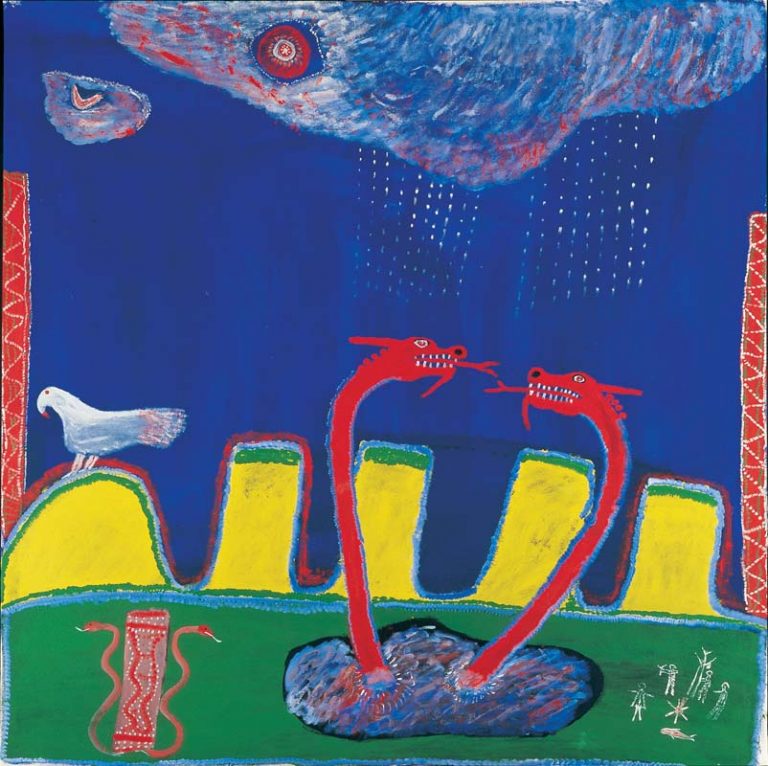We acknowledge the Traditional Owners of the land on which the Queensland Art Gallery | Gallery of Modern Art stands and recognise the creative contribution First Australians make to the art and culture of this country.

Ginger Riley Munduwalawala / Mara people, Narritj skin group / Australia 1937–2002 / Garimala (The Two Snakes) 1988 / Synthetic polymer paint on canvas / 178 x 177.4cm / Purchased 1990 with funds from ARCO Coal Australia Inc. through the Queensland Art Gallery Foundation / Collection: Queensland Art Gallery | Gallery of Modern Art / © The Estate of Ginger Riley Munduwalawala / Courtesy: Alcaston Gallery, Melbourne
Ginger Riley MunduwalawalaGarimala (The Two Snakes) 1988
Not Currently on Display
A prominent feature of the landscape near Ngukurr, where Ginger Riley Munduwalawala lived, is the Four Arches, a series of eroded volcanic rock formations. According to Mara legend, the Four Arches were created by two rival Dreaming creatures, the serpents Bandian and Bulukbun, the ancestors of Kurra Murra (king brown snake). Bandian represents order and stability, while Bulukbun represents disorder and chaos — a balance of these opposing forces is necessary for the continuation of life.
A third creature, Garimala, represents the ideal balance between competing natural forces. Also featured in this painting is Ngak Ngak, the totemic sea eagle. According to another legend, an island near the mouth of the Limmen Bight River was formed when Ngak Ngak flew over it. This was the ancestral country of Munduwalawala’s mother and is represented as the rounded formation upon which the sea eagle rests.
Ginger Riley Munduwalawala was an elder from Ngukurr, situated on the Roper River in south-eastern Arnhem Land in the Northern Territory. His ancestral land is some 45 kilometres from the mouth of Limmen Bight River in the Gulf of Carpentaria.
For Munduwalawala, the issues of ancestral land and heritage are inseparable from the creative process. His paintings emphasise the importance of his people’s ownership of the land. Originally he was inspired by the painting of Albert Namatjira, but he found the Western-influenced style difficult, and was unhappy with the results of his work.
In 1986, with the encouragement of the local school principal, he again experimented with painting, developing a distinctive, colourful and expressionistic style that brought him considerable fame. Munduwalawala employed bright, clear colours in acrylic to paint ancestral stories in a highly accessible style.
Discussion Questions
1. In his paintings, Munduwalawala used images we easily recognise. Can you see how his use of vibrant colour draws your attention to the painting? Do you need to know the dreaming story depicted to understand the work or is the message clear?
2. How do stories help us understand the importance of laws and rules? How is good behaviour encouraged at your school?
3. In Garimala (The Two Snakes), Munduwalawala depicts the balance of opposing forces. Many cultures explore the balance between good and evil, for example, Asian philosophies, superhero comics and Hollywood movies. Select an example and discuss what the opposing forces symbolise.
Classroom Activities
1. Research the role of elders and custodians in Indigenous custom and law. What role do seniors play in your community? Are there any similarities between elders and seniors?
2. Can you suggest an Aboriginal dreaming story that tells us about Indigenous custom or law? Share your story with the class.